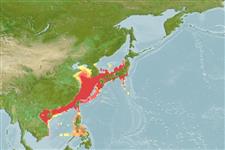Elasmobranquios (tiburones y rayas) (sharks and rays) >
Carcharhiniformes (Ground sharks) >
Triakidae (Houndsharks) > Triakinae
Etymology: Mustelus: Latin for weasel, an ancient name for sharks, possibly referring to the pointed snouts, swift movements and/or rapacious feeding behavior of smaller predatory sharks [strictly not tautonymous with Squalus mustelus Linnaeus 1758 since type was designated by the ICZN]. (See ETYFish); griseus: Medieval Latin for gray, referring to gray or gray-brown color. (See ETYFish).
Environment: milieu / climate zone / depth range / distribution range
Ecología
marino demersal; rango de profundidad 5 - 300 m (Ref. 104830), usually 51 - ? m (Ref. 104830). Tropical; 41°N - 11°N, 105°E - 142°E
Northwest Pacific: Japan, Korea, China, Taiwan, and Viet Nam (Ref. 244). Possibly occurring in the Philippines (Ref. 13563).
Length at first maturity / Tamaño / Peso / Age
Maturity: Lm 72.0, range 70 - 74 cm
Max length : 87.0 cm TL macho / no sexado; (Ref. 244); 101.0 cm TL (female); edad máxima reportada: 9 años (Ref. 6983)
An inshore bottom-dwelling shark found down to at least 51 m (Ref. 244); also dwells in semi-enclosed sea areas with sand bottom (Ref. 11230). Probably feeds on benthic invertebrates, especially crustaceans (Ref. 13563). Viviparous, with a yolk-sac placenta (Ref. 244).
Viviparous with a yolk-sac placenta. Produces 5 to 16 young per litter, with larger adults having larger litters of young. Gestation period is 10 months, birth occurring in April and May. Size at birth about 28 cm (Ref. 244).
Compagno, L.J.V., 1984. FAO Species Catalogue. Vol. 4. Sharks of the world. An annotated and illustrated catalogue of shark species known to date. Part 2 - Carcharhiniformes. FAO Fish. Synop. 125(4/2):251-655. Rome: FAO. (Ref. 244)
IUCN Red List Status (Ref. 130435)
Human uses
Pesquerías: comercial
Herramientas
Special reports
Download XML
Fuentes de Internet
Estimates based on models
Preferred temperature (Ref.
123201): 11.1 - 23.2, mean 18.5 °C (based on 212 cells).
Phylogenetic diversity index (Ref.
82804): PD
50 = 0.5000 [Uniqueness, from 0.5 = low to 2.0 = high].
Bayesian length-weight: a=0.00224 (0.00105 - 0.00478), b=3.14 (2.97 - 3.31), in cm total length, based on LWR estimates for this Genus-body shape (Ref.
93245).
Nivel trófico (Ref.
69278): 3.5 ±0.4 se; based on diet studies.
Generation time: 5.5 ( na - na) years. Estimated as median ln(3)/K based on 1
growth studies.
Resiliencia (Ref.
120179): Muy bajo, población duplicada en un tiempo mínimo superior a 14 años (tm=5.3-6.5; tmax=9; Fec=5).
Fishing Vulnerability (Ref.
59153): High vulnerability (59 of 100).
Nutrients (Ref.
124155): Calcium = 28.8 [8.9, 143.9] mg/100g; Iron = 0.482 [0.142, 1.730] mg/100g; Protein = 20.7 [18.3, 23.0] %; Omega3 = 0.0918 [, ] g/100g; Selenium = 85.5 [25.8, 320.1] μg/100g; VitaminA = 15.1 [5.3, 42.3] μg/100g; Zinc = 1.07 [0.47, 2.18] mg/100g (wet weight);
